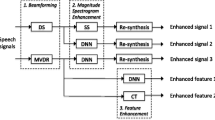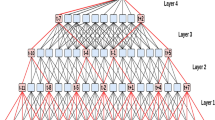Abstract
The recent proposed time-delay deep neural network (TDNN) acoustic models trained with lattice-free maximum mutual information (LF-MMI) criterion have been shown to give significant performance improvements over other deep neural network (DNN) models in variety speech recognition tasks. Meanwhile, the Kullback–Leibler divergence (KLD) regularization has been validated as an effective adaptation method for DNN acoustic models. However, to our best knowledge, no work has been reported on investigating whether the KLD-based method is also effective for LF-MMI based TDNN models, especially for the domain adaptation. In this study, we generalized the KLD regularized model adaptation to train domain-specific TDNN acoustic models. A few distinct and important observations have been obtained. Experiments were performed on the Cantonese accent, in-car and far-field noise Mandarin speech recognition tasks. Results demonstrated that the proposed domain adapted models can achieve around relative 7–29% word error rate reduction on these tasks, even when the adaptation utterances are only around 1 K.

Similar content being viewed by others
References
Bell, P., Gales, M., Lanchantin, P., Liu, X., Long, Y., Renals, S., et al. (2012). Transcription of multi-genre media archives using out-of-domain data. In Proceedings of Workshop on Spoken Language Technology, IEEE (pp. 324–329).
Christensen, H., Aniol, M. B., Bell, P., Green, P., Hain, T., King, S., et al. (2013). Combining in-domain and out-of-domain speech data for automatic recognition of disordered speech. In Proceedings of Interspeech, ISCA (pp. 3642–3645).
Fainberg, J., Bell, P., Lincoln, M., & Renals, S. (2016). Improving children’s speech recognition through out-of-domain data augmentation. In Proceedings of Interspeech, ISCA (pp. 1598–1602).
Gauvain, J., & Lee, C. (1992). MAP estimation of continuous density HMM: Theory and applications. In Proceedings of Workshop on Speech and Natural Language, Association for Computational Linguistics (pp. 185–190).
Huang, Y., Yu, D., Liu, C., & Gong, Y. (2014). Multi-accent deep neural network acoustic model with accent-specific top layer using the KLD-regularized model adaptation. In Proceedings of Interspeech, ISCA (pp. 2977–2981).
Huang, Z., Tang, J., Xue, S., & Dai, L. (2016). Speaker adaptation of RNN-BLSTM for speech recognition based on speaker code. In Proceedings of ICASSP, IEEE (pp. 5305–5309).
Legetter, c, & Woodland, P. (1995). Maximum likelihood linear regression for speaker adaptation of continuous density Hidden Markov models. Computer Speech and Language, 9, 171–185.
Mirsamadi, S., & Hansen, J. (2015). A study on deep neural network acoustic model adaptation for robust far-field speech recognition. In Proceedings of Interspeech, ISCA (pp. 2430–2434).
Peddinti, V., Povey, D., & Khudanpur, S. (2015). A time delay neural network architecture for different modeling of long temporal contexts. In Proceedings of Interspeech, ISCA (pp. 3214–3218).
Povey, D., (2005). Discriminative training for large vocabulary speech recognition. PhD dissertation, Cambridge University.
Povey, D., (2016). Kaldi code repository. Retrieved from https://github.com/kaldi-asr/kaldi.
Povey, D., Ghoshal, A., Boulianne, G., Burget, L., Glembek, O., Goel, N., et. al. (2011). The Kaldi speech recognition toolkit. In Proceedings of ASRU, IEEE (pp. No. EPFL–CONF–192584).
Povey, D., Peddinti, V., Galvez, D., Ghahrmani, P., Manohar, V., Na, X., et al. (2016). Purely sequence-trained neural networks for ASR based on lattice-free MMI. In Proceedings of Interspeech, ISCA (pp. 2751–2755).
Qian, Y., Tan, T., Yu, D., & Zhang, Y. (2016). Integrated adaptation with multi-factor joint-learning for far-field speech recognition. In Proceedings of ICASSP, IEEE (pp. 5770–5774).
Sak, H., Senior, A., Rao, K., & Beaufays, F. (2015). Fast and accurate recurrent neural network acoustic models for speech recognition. In Proceedings of Interspeech, ISCA (pp. 1468–1472).
Saon, G., Soltau, H., Nahamoo, D., & Picheny, M. (2013). Speaker adaptation of neural network acoustic models using i-vectors. In Proceedings of ASRU, Olomouc (pp. 55–59).
Senior, A., & Lopez-Moreno, I. (2014). Improving DNN speaker independence with i-vector inputs. In Proceedings of ICASSP, IEEE (pp. 225–229).
Senior, A., Sak, H., de Chaumont Quitry, F., Sainath, T., & Rao, K. (2015). Acoustic modeling with CD-CTC-SMBR LSTM RNNs. In Proceedings of ASRU, IEEE (pp. 604–609).
Toth, L., & Gosztolya, G. (2016). Adaptation of DNN acoustic models using KL-divergence regularization and multi-task training, In Proceedings of SPECOM. (pp. 108–115).
Xue, S., Abdel-Hamid, O., Jiang, H., Dai, L., & Liu, Q. (2014). Fast adaptation of deep neural network based on discriminant codes for speech recognition. IEEE/ACM Transactions on Audio, Speech, and Language Processing, 22, 1713–1725.
Yu, D., & Deng, L. (2014). Automatic speech recognition: A deep learning approach (1st ed.). New York: Springer.
Yu, D., Yao, K., Su, H., Li, G., & Seide, F. (2013). KL-divergence regularized deep neural network adaptation for improved large vocabulary speech recognition. In Proceedings of ICASSP, IEEE (pp. 7893–7897).
Acknowledgements
This work was funded by the Shanghai Science and Technology Development Funds (Grant No.14YF1409300), and the Research Foundation of Young Teachers Program in Universities of Shanghai (Grant No. ZZshsf14026). Thanks to Beijing Unisound Information Technology Co., Ltd (http://www.unisound.com/) for providing the data sets of system training and test.
Author information
Authors and Affiliations
Corresponding author
Rights and permissions
About this article
Cite this article
Long, Y., Li, Y., Ye, H. et al. Domain adaptation of lattice-free MMI based TDNN models for speech recognition. Int J Speech Technol 20, 171–178 (2017). https://doi.org/10.1007/s10772-017-9399-z
Received:
Accepted:
Published:
Issue Date:
DOI: https://doi.org/10.1007/s10772-017-9399-z




